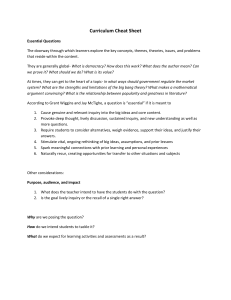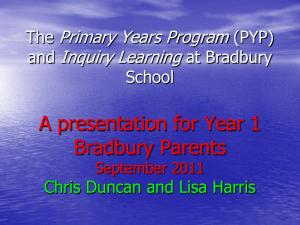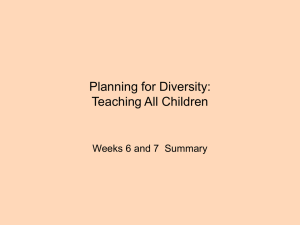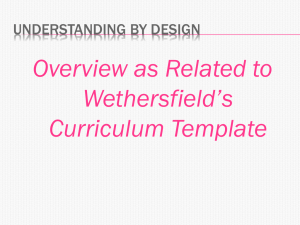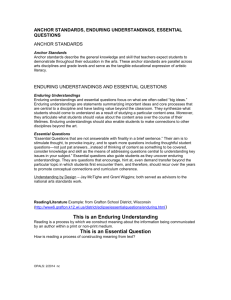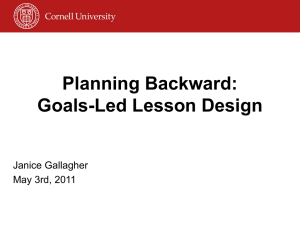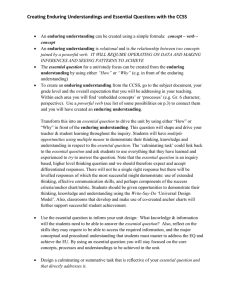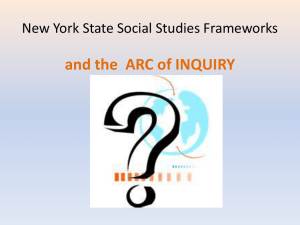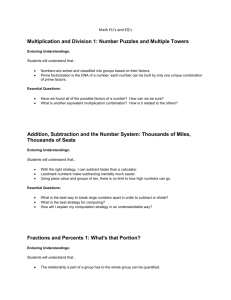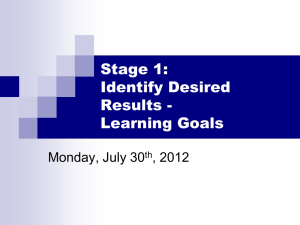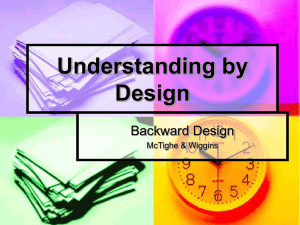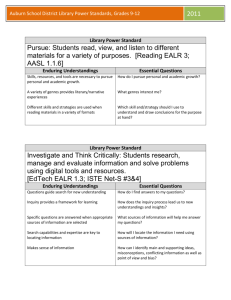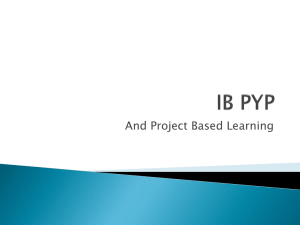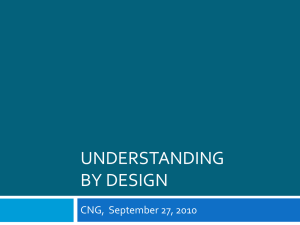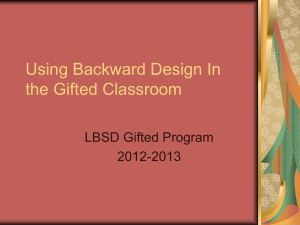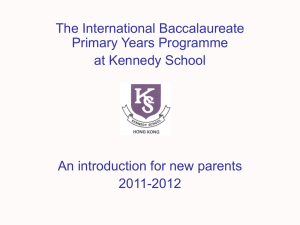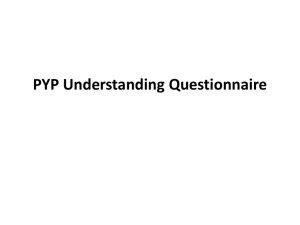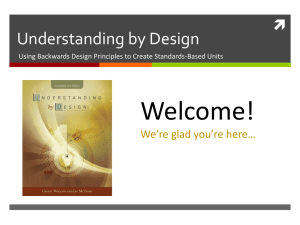Reading and Writing Through Inquiry - kinder-CCB
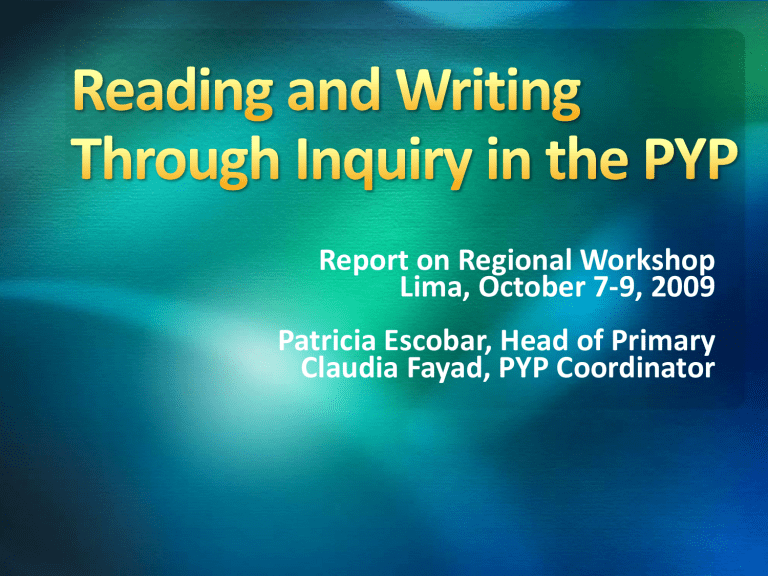
Report on Regional Workshop
Lima, October 7-9, 2009
Patricia Escobar, Head of Primary
Claudia Fayad, PYP Coordinator
Reading and Writing through inquiry is an effective way for learners to be actively involved in constructing their own meaning by reading, writing, listening, speaking, viewing and presenting.
CONNECTION
PERSPECTIVE
Communication
Beliefs
RESPONSIBILITY Initiative
Our own literacy histories
Our beliefs, theories and practices
Language as a tool for inquiry and thinking
Developing balance in Language Arts
Who are you as a reader and a writer now?
How would I know if you are a reader and a writer if I walked into your classroom?
What kind of a reader and writer would I assume you are?
How do you make it explicit to your students who you are as a writer and a reader?
Why is this important?
Decoding Perspective
Skills Perspective
Whole Language Perspective
BALANCED APPROACH
Inquiry enhances learning
Inquiry weds the Social, the Intellectual and the Personal Self
Inquiry requires the managing of imposition
Curious
Searching for meaning
Intelligent in a range of ways
Experienced/something to offer
Thinkers
Collaborators
Active
Risk-takers
Co-learners and co-teachers
INFORMATION-SEEKING
Inclined toward closure
Elicit information
Work-ful
The goal is product
Something to be known, confirmed or explained
GOING AFTER SOMETHING
Home is actual world
Dealing with the factual
WONDERING
Attempt to hold discourse open
Inviting conjecture and speculation
Playful
The goal is engaging in the process itself
Reflecting primarily for its own self
REFLECTING ON SOMETHING
Home is possible worlds
Dealing with possibility
Connections—elicited
Creativity—safe & trusting environment
Collaboration—active listening enforced
In-Process—‘rough-draft’ talk encouraged
Variety—expressive forms & discourse, diverse perspectives valued
Present information and skills
Activities need to be structured in open-ended ways:
Case-study comparison
Venn Diagram summarising
Mind-mapping discoveries
Sharing in groups
Article jigsaw
Reflective journals
Students need
EXPOSURE
EXPERIENCE
TIME
Teach skills
Discuss perspectives
Connect to central idea
How to get students to be better readers and writers?
BY HAVING THEM READ AND WRITE!
The more they read, the better readers they will become!
The more they write, the better writers they will become!
Make children WANT TO LEARN to Read and Write (fun & useful)
Make sure you have Reading and Writing activities with children EVERY DAY
Reading and Writing with young children:
TO them
WITH them
BY themselves
Guided Reading
Reading Comprehension strategies
Independent Reading
Read-aloud
Sustained Silent Reading & conferencing
“Recommend a Book”
Writing
Writing mini-lesson
Independent Writing & conferencing
“Author’s Chair”
Word Work
Phonemic Awareness & Phonics
Rhyming words, beginning & ending sounds
CVC, CVCe patterns
Spelling
Reading
Shared Reading (with)
Guided Reading (with and by)
Independent Reading (reading by)
Writing
Expressive Writing
Personal—e.g.: newsboard, personal recounts, shopping lists, Christmas lists, diaries
Poetic writing
Retelling known stories, poetry labels for illustrations, language experiences, picture webs, books reports, comics
Transactional Writing
Factual—e.g.: writing instructions and recount events
L1 is empowering
L1 lowers affective filter, makes it easier
L1 makes input comprehensive
L1 allows successful predictions about target language
L1 allows transfer (e.g.: knowledge of literacy, concepts)
L1 is a tool for authentic inquiry
“No understanding—no engagement— no learning!”
Making the PYP Happen: Language in the
Primary Years Programme (pg. 68)
Language Scope & Sequence: Introduction
Programme Standards & Practices
(best reference!)
Children’s Picturebooks (University of Miami
Ohio) Database of more than 9000 books http://www.lib.muohio.edu/pictbks/search/
In groups of 4
Select a picture book
Design a literature-based engagement
Children (and teachers) have beliefs about what good reading/writing is, which affects how they learn
Enduring Understandings II
Inquiry is a philosophical stance that underlies everything we do in school
Enduring Understandings III
The PYP holds a specific philosophy and belief system about the teaching of
Reading and Writing to which we have a responsibility to adhere
Enduring Understandings IV
Reading and Writing are tools for thinking about the self and the world
Enduring Understandings V
There are authentic opportunities for the development of Reading and Writing through the units of inquiry
Enduring Understandings VI
There are connections between oral, visual and written language
Enduring Understandings VII
A balanced literacy curriculum is comprised of three interdependent aspects:
Learning LANGUAGE
Learning ABOUT language
Learning THROUGH language
Enduring Understandings VIII
Reading and Writing in the PYP can be supported by a variety of resources that align with the philosophy of the programme

